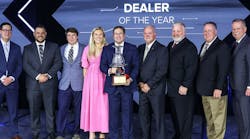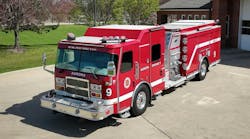It is common practice in many states (New Jersey, New York and Pennsylvania, to name a few) for volunteer fire chiefs, fire marshals, fire coordinators, emergency medical technicians (EMTs) and arson investigators to install emergency lights and sirens on their personal vehicles. In other states (including Massachusetts, Michigan and Wisconsin) it is common practice for firefighters and EMTs to put emergency lights and sirens on their personal vehicles.
For example, Wisconsin vehicle and traffic law, under emergency vehicle definitions, includes the following:
"Privately owned motor vehicles being used by deputy state fire marshals or by personnel of a full-time or part-time fire department or by members of a volunteer fire department while enroute to a fire or on an emergency call pursuant to orders of their chief or other commanding officer.
"A privately owned motor vehicle which is:
"1. Designated or authorized by an ambulance service or rescue squad chief in writing annually;
"2. Used by an emergency medical technician licensed under §.146.50 or an ambulance driver or first responder authorized by the chief of an ambulance service or rescue squad."
The question now becomes who is insuring this vehicle? Probably you the owner, so what personal liability have you incurred by turning your car into an emergency vehicle?
First, let us look at two case studies. Case one involves a volunteer fire chief. The fire department received a call for a motor vehicle accident at 2 A.M. The chief jumped into his personal pickup truck and turned on the warning lights and siren. (The warning devices were supplied by the fire department and owned by the village.) While he was responding to the accident, a car crashed into the chief's pickup truck. The pickup truck sustained $4,600 in damage, and the accident was found to be 60% the fault of the civilian driver and 40% the fault of the fire chief. Who pays?
The fire chief first asked the fire department to cover the 40% because the accident occurred while he was acting in his capacity as fire chief. The department told the chief to confront the mayor of the village, as the chief was acting as an agent of the village. The village told the chief, "We neither own nor insure your car. How can we pay?" It was decided that because the village owned the lights and siren it would pay the 40% to have the chief's pickup truck repaired. It was further decided that the village would obtain vehicles owned and insured by the village for the chief and his two assistants.
The second case study involved a volunteer assistant fire chief who was responding in his personal van to a working fire. The van skidded on a patch of black ice and struck a bridge, causing $2,000 in damage to the van.
The assistant chief, not wanting to put a claim into his insurance company as he felt he was acting as an agent of the fire district, sought payment from the district commissioners for the $2,000 repair bill. Again, the district did not own or insure the assistant chief's vehicle. Its hands were tied. However, it was agreed that the district would pay for the repairs out of its general fund. Six months later, however, the district underwent a state audit and was admonished for paying the repairs on a vehicle that it did not own.
I consulted the American Insurance Association and here is the information it provided: The volunteer department or municipal motor vehicle insurance policy would cover vehicles owned by the department or the municipality. Vehicles owned by firefighters would not likely be included in the basic policy.
In this case, the firefighter's only coverage is the policy he or she has purchased. However, the volunteer fire department or the municipality could purchase additional "non-owned vehicle coverage." This additional protection for the firefighter's vehicle would be over and above the coverage the firefighter has purchased. That means the firefighter's personal auto coverage will pay until the limits of the policy are exhausted. Additional damages owed the injured or their families would be covered by the non-owned vehicle coverage of the fire department or the municipality up to the limits of that policy. If there is no non-owned vehicle coverage and damages exceed the firefighter's personal policy, the firefighter could be personally responsible for the damages exceeding his or her policy amount.
Because the firefighter may pose more than the ordinary motor vehicle accident risk, he or she should usually carry an amount significantly greater than the minimum coverage required by law. This coverage varies from state to state and is often in the range of $25,000 to $50,000 per person for bodily injury liability coverage for all victims in any one accident and $10,000 property damage liability. Firefighters with assets to protect should consider buying much more insurance and purchasing a liability "umbrella policy" that will increase limits by $1 million to $5 million, depending on how much additional coverage is needed.
I would like to thank the American Insurance Association for its help in the preparation of this column.
Michael Wilbur, a Firehouse® contributing editor, is an FDNY lieutenant in Ladder Company 27 in the Bronx and a firefighter in the Howells, NY, Fire Department. He is an adjunct instructor at the New York State Academy of Fire Science and the Orange County Fire Training Center. Wilbur has developed and presented emergency vehicle operator courses throughout the country and has consulted on a variety of fire apparatus issues.




